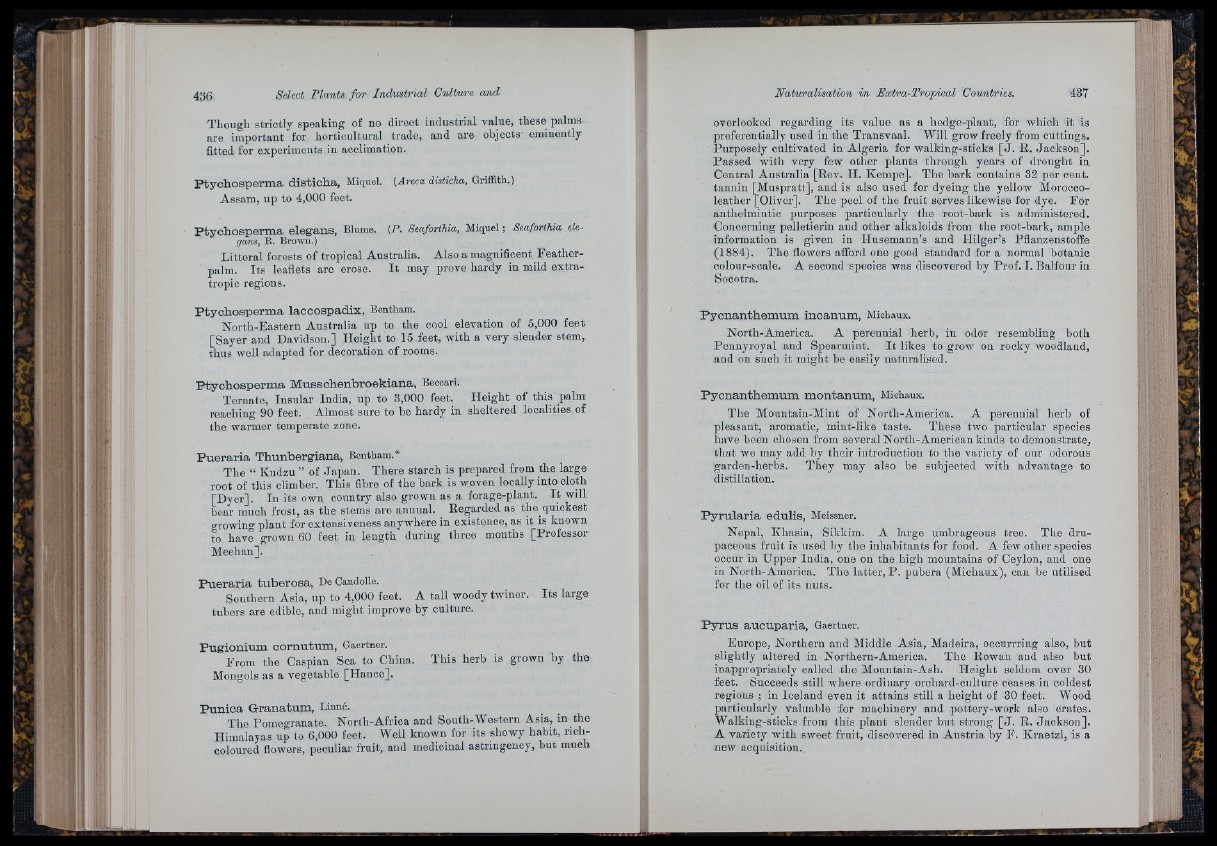
Though strictly speaking of no direct industrial value, these palms
are important for horticultural trade, and are objects' eminently
fitted for experiments in acclimation.
Ptychosperma disticha, Miquel. [Areca disticha, Griffith.)
Assam, up to 4,000 feet.
Ptychosperma elegans, Blume. [P. Seaforthia, M iq u e l; Seaforthia elegans,
R. Brown.)
Littoral forests of tropical Australia. Also a magnificent Feather-
palm. Its leaflets are erose. I t may prove hardy in mild extra-
tropio regions.
Ptychosperma laccospadix, Bentham.
North-Eastern Australia up to the cool elevation of 5,000 feet
[Sayer and Davidson.] Height to IS feet, with a very slender stem,,
thus well adapted for decoration of rooms.
Ptychosperma Mussohenbroekiana, Becoari.
Ternate, Insular India, up to 3,000 feet. Height of this palm
reaching 90 feet. Almost sure to be hardy in sheltered localities of
the warmer temperate zone.
Pueraria Thunbergiana, Bentham.*
The “ Kudzu ” of .Tapan. There starch is prepared from the large
root of this climber. This fibre of the hark is woven locally into cloth
[Dyer]. In its own country also grown as a forage-plant. I t will
bear much frost, as the stems are annual. Regarded as the quickest
growing plant for extensiveness anywhere in existence, as it is known
to have grown 60 feet in length during three months [Professor
Meehan].
Pueraria tuberosa, De Candolle.
Sonthern Asia, np to 4,000 feet. A tall woody twiner. Its large
tubers are edible, and might improve by culture.
Pugionium cornutum, Gaertner.
From the Caspian Sea to China.
Mongols as a vegetable [Hance].
This herb is grown by the
Púnica Granatum, Linné.
The Pomegranate. North-Africa and South-Western Asia, in the
Himalayas up to 6,000 feet. Well known for its showy habit, rich-
coloured flowers, peculiar fruit, and medicinal astringency, but much
overlooked regarding its value as a hedge-plant, for which it is
preferentially used in the Transvaal. Will grow freely from cuttings.
Purposely cultivated in Algeria for walking-sticks [ J . R. Jackson].
Passed with very few other plants through years of drought in
Central Australia [Rev. II. Kempe], The bark contains 32 per cent,
tannin [Muspratt], and is also used for dyeing the yellow Morocco-
leather [Oliver]. The peel of the fruit serves likewise for dye. For
anthelmintic purposes particularly the root-bark is administered.
Concerning pelletieriu and other alkaloids from the root-bark, ample
information is given in Husemann’s and Hilger’s Pflanzenstofle
(1884). The flowers afford one good standard for a normal botanic
colour-scale. A second species was discovered by Prof. I. Balfour in
Socotra.
Pycnanthemum incanum, Michaux.
North-America. A perennial herb, in odor resembling both
Pennyroyal and Spearmint. I t likes to grow on rooky woodland,
and on such it might he easily naturalised.
Pycnanthemum montanum, Miohaux.
The Mountain-Mint of North-America. A perennial herb of
pleasant, aromatic, mint-like taste. These two particular species
have been chosen from several North-American kinds to demonstrate,
th a t we may add by their introduction to the variety of our odorous
garden-herbs. They may also be subjected with advantage to
distillation.
Pyrularia edulis, Meissner.
Nepal, Khasia, Sikkim. A large umbrageous tree. The drupaceous
fruit is used by the inhabitants for food. A few other species
occur in Upper India, one on the high mountains of Ceylon, and one
in North-America. The latter, P . púbera (Michaux), can be utilised
for the oil of its nuts.
Pyrus aucuparia, Gaertner.
Europe, Northern and Middle Asia, Madeira, ocourrring also, but
slightly altered in Northern-America. The Rowan and also but
inappropriately called tbe Mountain-Ash. Height seldom over 30
feet. Succeeds still where ordinary orchard-culture ceases in coldest
regions ; in Iceland even it attains still a height of 30 feet. Wood
particularly valuable for machinery and pottery-work also crates.
Walking-sticks from this plant slender but strong [ J . R. Jackson].
A variety with sweet fruit, discovered in Austria by F. Kraetzl, is a
new acquisition.